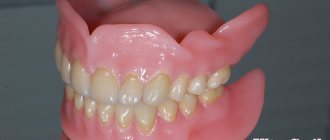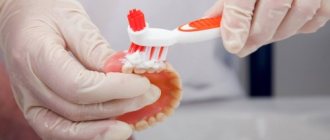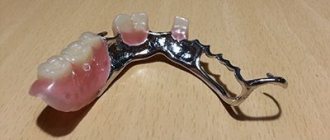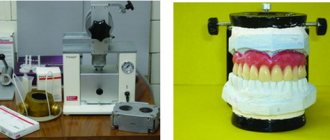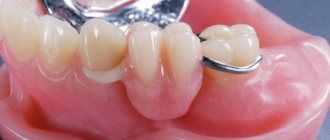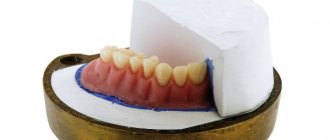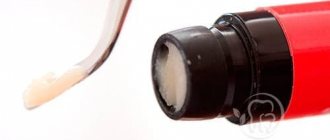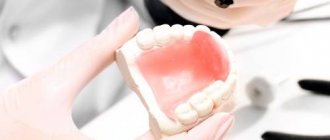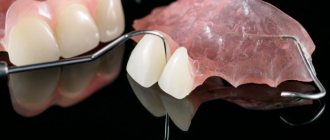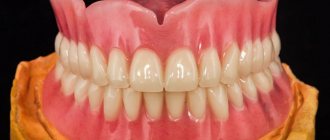Classification of elastic polymers
Elastic polymers are made from different materials:
- acrylic;
- polyvinyl chloride;
- vinyl chloride with butyl acrylate;
- siloxane or silicone;
- fluoroelastomer
Elastic polymers belong to one of two groups - plastics with high or low temperature polymerization. Available in the form of a gel, elastic sheets, a set of powder and liquid, or in the form of a laminated gel or in cartridges. The powder is a copolymer of acrylic monomers.
Molding fluid is a mixture of acrylic monomers or methyl methacrylate containing a plasticizer and some organic solvents. The second option is a liquid made from acrylic monomers - for fast-hardening plastics.
Daily hygiene procedures
You need to clean your dentures after every meal. The exception is structures that are fixed using an adhesive cream. In this case, you can do extraoral brushing once a day.
Rules for performing daily hygiene procedures:
- You need to clean your denture under running water, being careful not to drop it in the sink or on the floor.
- Only soft brushes and special products or non-abrasive toothpastes are suitable for processing.
- It is important to ensure that the plastic parts of the structure and metal hooks do not bend during cleaning.
Polyvinyl chloride materials
Polyvinyl chlorides, high-temperature polymerization plastics, are available in powder-liquid configurations and in the form of a laminated gel. These materials are considered the ancestors of elastic polymers. In structure, they are copolymers of vinyl chloride with other monomers. A high degree of elasticity is achieved through external plasticization.
Such plastics resist abrasion better than silicone and acrylic, but are less attached to a rigid base. The presence of a plasticizer in the composition causes shortcomings of the material - its migration and aging.
Silicone base materials
These materials are characterized by stable elasticity. The cold polymerization material is technologically advanced and can be worked with without the need for a dental laboratory. It is inert and does not swell in the oral cavity, is not susceptible to the influence of microflora on the lips, does not contain plasticizers, and therefore retains its original elasticity for several years.
Cold vulcanized silicone is a filled silicone composition in the form of a paste and a catalyst liquid. The first two liquids in the composition are vulcanization catalysts, the third is a soil adhesive. The paste contains silicone rubber and organosilicon dioxide, as well as a dye.
Silicone materials are used as a temporary soft layer for a period of up to 4 weeks. Adhesive must be used before application. The substance ages quickly and loses elasticity because it has little resistance to abrasion. Silicone polymers are characterized by insufficient adhesion to the acrylic base and low tensile strength. They are labor-intensive to correct, have weak shock-absorbing properties and are expensive. The mechanical strength of the material is increased by selecting rubber with optimal molecular weight and reinforcing fillers.
Despite the fact that the technology for manufacturing the base of a removable denture from acrylic plastics was first proposed in 1935 and since then many new polymers have appeared, compositions based on derivatives of acrylic and methacrylic acids still hold one of the first places in terms of the frequency of their use [1 ].
The popularity of acrylic polymers is explained by their high manufacturability, as well as the combination of low cost and good physical and mechanical characteristics. The main disadvantage of acrylic plastics is the presence of residual monomer, which can lead to inflammation of the mucous membrane, called “acrylic stomatitis” [2].
Based on the above, the interest in new acrylic polymers for the manufacture of removable denture bases and their comparison with existing analogues becomes clear.
Purpose of the study
— conducting a comparative analysis of the technical characteristics of new polymer acrylic base materials (Belgorod, Russia) with existing base polymers (Kharkov, Ukraine; Novocheboksarsk, Russia).
Material and methods.
Two types of acrylic polymers were used as test samples: cold-curing acrylic plastics and hot-curing acrylic plastics. The cold-curing acrylic plastics tested include the materials belacryl-M XO and belacryl-E XO (Russia) and the material protacryl-M (Ukraine). The main purpose of this type of material is to repair and reline dentures. The letter “M” in the name of the material belacryl-M XO indicates that methyl methacrylate is used as the main component of the liquid. The letter “E” indicates that the main component of the liquid of the Belacryl-E XO material is ethyl methacrylate. This type of material is mainly used for repairing and relining removable denture bases. The second type of tested materials are hot-curing acrylic plastics belacryl-M GO and belacryl-E GO (Russia), materials fluorax and ethacryl-02 (Ukraine), as well as olacryl material (Russia). As in the previous case, the materials belacryl-M GO and belacryl-E GO differ in that they use either methyl methacrylate or ethyl methacrylate as the main component of the liquid. The main purpose of this type of material is the production of bases for removable dentures. We determined the quality of base plastics of both types based on GOST 31572–2012 “Polymer materials for denture bases. Technical requirements. Test methods". It should be noted that due to the lack of a gas chromatograph, we had to develop a method for analyzing the test samples according to the indicator “Residual monomer content” for a liquid chromatograph. In this case, sample preparation of the test samples was carried out in accordance with GOST.
Results.
During this work, it was revealed that the cold-curing acrylic polymers listed above significantly differ from each other in terms of “Bending Strength”, “Elasticity Modulus” and “Residual Monomer Content”. For other indicators described in GOST 31572–2012, the materials differ from each other within the limits of measurement error. The situation is identical with hot-curing acrylic materials. It should be noted that the indicators “Bending strength” and “Elastic modulus” characterize the product’s resistance to destruction, and the indicator “Residual monomer content” characterizes the degree of its allergenicity. As a result of the work performed for cold-curing acrylic plastics, the following data were obtained:
— the belacryl-M XO material has an elastic modulus of 2581±225 MPa, the flexural strength for this material was 83.2±11.3 MPa, and the content of residual methyl methacrylate monomer is 1.19±0.05%;
— the belacryl-E XO material has an elastic modulus of 2186±223 MPa, the flexural strength for this material was 71.4±4.9 MPa, and the content of residual methyl methacrylate monomer is 0.19±0.04%;
— the protacryl-M material has an elastic modulus of 2557±191 MPa, the flexural strength for this material was 95.2±6.0 MPa, and the content of residual methyl methacrylate monomer is 1.63±0.05%.
GOST 31572–2012 requirements for cold-curing materials: for the “Elastic modulus” indicator - no less than 1500 MPa, for the “Bending Strength” indicator - no less than 60 MPa, for the “Residual monomer content” indicator - no more than 4.5%.
The following data were obtained for hot-curing acrylic plastics:
— the belacryl-M GO material has an elastic modulus of 2576±224 MPa, the flexural strength for this material was 86.2±20.0 MPa, and the content of residual methyl methacrylate monomer is 1.03±0.07%;
— the belacryl-E GO material has an elastic modulus of 2289±281 MPa, the flexural strength for this material was 74.8±9.4 MPa, and the content of residual methyl methacrylate monomer is 0.16±0.06%;
— the fluorax material has an elastic modulus of 2952±80 MPa, the flexural strength for this material was 101.4±4.1 MPa, and the content of residual methyl methacrylate monomer is 1.11±0.05%;
— the material ethacryl-02 has an elastic modulus of 2543±340 MPa, the flexural strength for this material was 94.1±7.4 MPa, and the content of residual methyl methacrylate monomer is 1.04±0.06%;
— the olacryl material has an elastic modulus of 2506±68 MPa, the flexural strength for this material was 82.0±10.4 MPa, and the content of residual methyl methacrylate monomer is 0.74±0.05%.
GOST 31572–2012 requirements for hot-curing materials: for the “Elastic modulus” indicator - no less than 2000 MPa, for the “Bending Strength” indicator - no less than 65 MPa, for the “Residual monomer content” indicator - no more than 2.0%.
Conclusion.
All analyzed cold and hot curing materials comply with the requirements of GOST 31572–2012. Since the purpose of cold-curing base polymer materials differs from the purpose of hot-curing base polymer materials, and in addition, the requirements of GOST 31572–2012 for these types of materials differ, the analysis of the data obtained must also be carried out separately for each type of material. Among cold-curing acrylic polymer base materials, the material protacryl-M has the greatest strength, and the material belacryl-E H.O. has the least strength. As for the content of residual methyl methacrylate monomer, in the belacryl-E XO material it is 8.5 times less than in the protacryl-M material, and 6.3 times less than in the belacryl-M XO material. Among hot-curing acrylic polymer base materials, a similar picture is observed. The materials fluorax and ethacryl-02 have the greatest strength, and belacryl-E G.O. has the least strength. As for the content of residual methyl methacrylate monomer, in the belacryl-E GO material it is 6.9 times less than in the fluorax material, and 6.5 times less than in the ethacryl-02 material. The belacryl-M GO material contains approximately the same amount of residual monomer as the ethacryl-02 material, and the olacryl material contains approximately 30% less residual monomer than the belacryl-M GO and ethacryl-02 materials. Thus, we see that among the studied polymer base materials, not a single material was found that was superior to the others in all characteristics. A lower strength value is compensated by a lower residual monomer content and vice versa.
Disadvantages of elastic base polymers
- Rapid aging.
- Loss of strength and elasticity.
- Inability to polish the elastic layer - especially after correction of a denture on implants or another type.
- Unhygienic due to excessive looseness.
- Insufficient marginal contact of the elastomer with rigid base plastics.
- Difficulty in processing with cutting tools and problems with base correction.
To get rid of these shortcomings, new methods of modifying plastics are being developed, aimed at modifying the physical and mechanical properties and increasing the strength of the connection between the hard and elastic layers. Using topcoat varnishes, they improve external characteristics, reduce surface tension, and help increase the fixation of the prosthesis.
Alternative solutions
The only alternative to a metal-plastic prosthesis at the first stage of prosthetics after installation of implants can only be a ceramic-composite prosthesis. In general, the final cost of basal implantation using both types of structures is identical. Those. when undergoing re-prosthetics, the patient will have to pay an additional 150 thousand rubles (depending on the material) for the manufacture of a permanent prosthesis. Therefore, the only difference is the necessity or absence of the second stage of prosthetics, as well as the amount that will have to be paid immediately at the time of concluding a contract for dental implantation.
